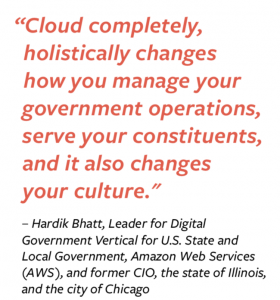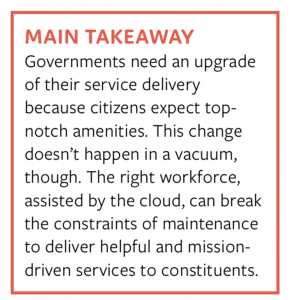This article is an excerpt from GovLoop’s recent guide, “Intelligent Innovation: Tech Trends Taking Root in State and Local Governments.” Download the full guide here.
What goes around comes around. People often get into IT and service delivery because they’re enthralled by cellphones, video games and robots. These same people want to further the progress of these technologies and develop new ones, such as drones, driverless cars and virtual reality.
Expectations of modernity are just a part of 21st-century life, so when state and local governments are operating off of mainframes and delivering outmoded interfaces, nobody’s happy – not public sector employees who want to deliver change, and certainly not constituents. Fortunately, the cloud can help.
To learn how the cloud can recruit an innovative government workforce to deliver better services to the public, GovLoop spoke with Hardik Bhatt, Leader for the Digital Government Vertical for U.S. State and Local Government at Amazon Web Services (AWS). Before coming to AWS, which offers on-demand cloud computing platforms to governments at all levels, Bhatt separately served as chief information officer (CIO) for Chicago and Illinois.
“Cloud completely, holistically changes how you manage your government operations, serve your constituents, and it also changes your culture,” Bhatt said.
Government IT systems can be decades old and expensive to maintain. Bhatt said when he was CIO for Illinois, 70% of his investment went toward a faltering and aging mainframe. While Illinois tried to innovate under his tenure, the state struggled to make all of the strides he wanted it to – because of ball and chain on-premise systems.
Recruiting young workers to government positions can be difficult enough, but potential employees can be further repelled by poor technology.
Cloud expedites workflows and energizes workforces. Anchored by cloud, Maryland’s Total Human-services Integrated Network (MD THINK) program was able to quickly evaluate cases, determine aid and report remotely. Because of the cloud, service delivery efficiency went up, and costs went down, meaning that caseworkers could spend more time in the field helping children and less time behind a desk doing paperwork.
Bhatt said that instrumental behind successful cloud adoptions is dropping a project mindset to focus on products. Whereas projects can get caught up in organizational potholes, products directly provide benefits to constituents.

“When you think about product, the first stakeholder that comes to mind is a customer,” Bhatt said.
AWS lets government employees streamline their work and discover capabilities in the cloud, while using familiar suites of applications that are user-friendly and familiar. These services can be immediately turned into front-facing services, such as customer service and election portals, and AWS offers training programs for government employees.






Leave a Reply
You must be logged in to post a comment.